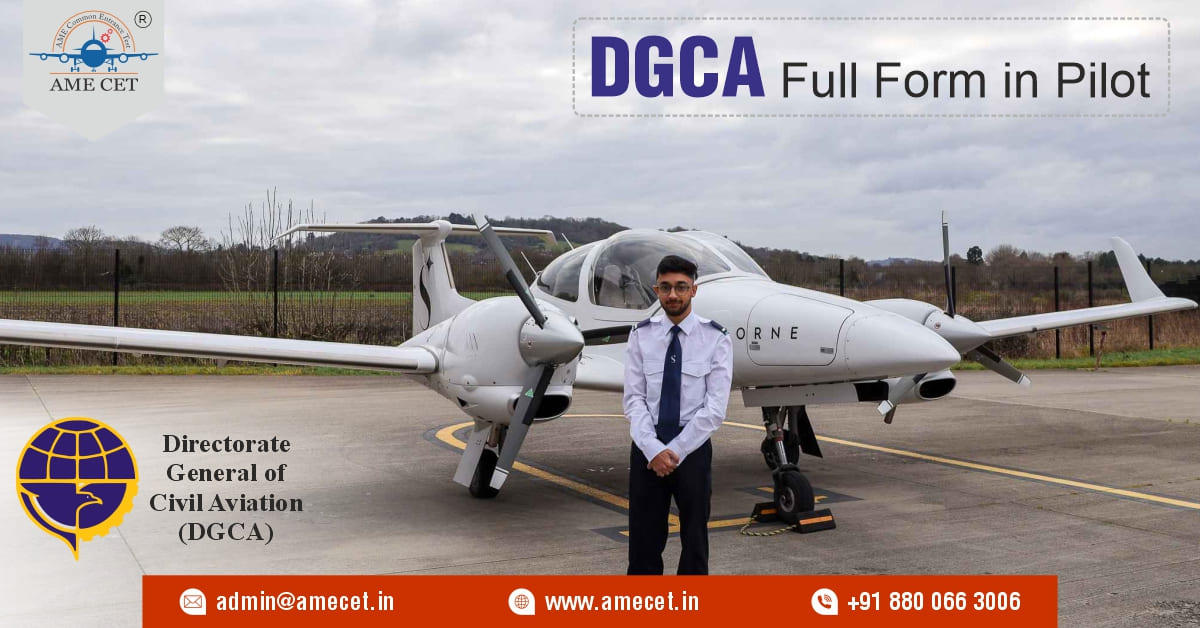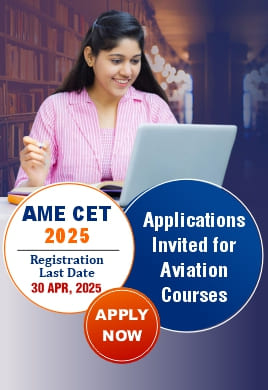
DGCA Full Form in pilot is Directorate General of Civil Aviation (DGCA), it is the regulatory authority of India that is responsible for overseeing and regulating civil aviation in India. When it comes to pilot training, DGCA plays very importannt role in establishing and enforcing standards for pilot licensing, training and safety. Aspiring pilots in India must undergo rigorous training, examinations and certification under the supervision of the DGCA to ensure they meet the highest national and international aviation safety standards. The DGCA also co-ordinates all regulatory functions with the International Civil Aviation Organisation (ICAO).
The DGCA is responsible for issuing various types of pilot licenses, like Private Pilot License (PPL), Commercial Pilot License (CPL) and Airline Transport Pilot License (ATPL), each and every license requires specific training, knowledge and practical experience. DGCA Full Form in pilot is Directorate General of Civil Aviation (DGCA) which is the regulatory authority through its regulatory framework, the DGCA ensures that Indian pilots are well-equipped to operate aircraft safely, efficiently and in compliance with both Indian and global aviation regulations.
Role of DGCA in Pilot Operations
The Director General of Civil Aviation is only one body created to ensure safe, effective regulation and operational safety in pilot services in India. Its role consists of the following specifications:
-
Licensing and Certification of Pilots: DGCA is also tasked with issuing instructions to the pilot for allowing flight certificates like the Private Pilot License (PPL), Commercial Pilot License (CPL) and Airline Transport Pilot License (ATPL). This licensing is done with all the necessary educational background and hours of flying experience necessary for the pilot.
-
Training Standards and Regulations: To ensure the kind of daily running operations each potential flight training school will have, DGCA sets standards. DGCA goes further to give accreditation to flight trainers making sure they posses the capabilities to conduct the training activities required for the pilot to meet standards provided by the international aviation safety standard.
-
Safety and Compliance Monitoring: The topmost function it has is to monitor safety processes in pilotage, especially licensing of pilots. A medical examination should be done periodically and it must provide proficiency checks on pilot's licenses, both in terms of flying hours and operationalization standards.
-
Accident Investigation and Safety Issues: While aviation accidents or incidents occur, the Indian Aviation Board moves forward to inquire about the incidents, pinpoint the reason why each happened, present the certain improvements in the safety measures and provide corrective measures for avoiding its recurrence in the future.
-
Regulating Flight Operations: The DGCA ensures that the regulation of safety laws observed by pilots should also consider the environment and airspace within which pilots operate. The Directorate General of Civil Aviation also oversees the management of air traffic controlled areas to ensure that they are effectively operated in the air movement.
-
International Standards Compliance: DGCA makes sure that Indian pilots can operate not only within India but also internationally by ensuring they meet International Civil Aviation Organization, generally known as ICAO, requirements.
Pilot Eligibility Criteria (As per DGCA Guidelines)
To pursue a career as a pilot under the DGCA’s regulatory framework, candidates must meet specific eligibility requirements. Below is a detailed explanation of the criteria:
| Criteria | Details |
|---|---|
|
Minimum Age |
SPL: 17 years CPL: 18 years |
|
Education |
10+2 with Physics and Mathematics or equivalent (open schooling recognized by DGCA). |
|
Medical Fitness |
Class 1: Required for CPL. |
|
Vision Standards |
6/6 in one eye and 6/9 in the other (correctable to 6/6); mild color blindness may qualify. |
|
Hearing Standards |
Clear hearing of conversational speech at 6 feet (with or without aids). |
|
Language Proficiency |
English proficiency, minimum ICAO Level 4. |
Syllabus for Pilot Training (DGCA-Certified)
Theoretical Knowledge
The theoretical portion of pilot training covers the foundational knowledge necessary for flying, including:
-
Air Navigation: Understanding navigation principles, charts, air traffic communication and navigating weather conditions.
-
Meteorology: Studying weather patterns, interpreting forecasts and understanding their impact on flight operations.
-
Aircraft and Engines: Learning about aircraft systems, engine operations, maintenance and performance basics.
-
Air Regulations: Familiarization with DGCA guidelines, ICAO standards and aviation laws.
-
Flight Planning: Calculating flight routes, fuel management, weight balance and risk assessment.
-
Aviation Safety and Human Factors: Learning about safety systems, emergency protocols and human factors in aviation decision-making.
Practical Training
Practical training provides hands-on experience in flying and includes:
-
Flying Hours: A minimum of 200 hours of flight training is required for obtaining a Commercial Pilot License (CPL).
-
Solo Flights: Independent flying to demonstrate basic maneuvers, emergency handling and decision-making.
-
Cross-Country Flights: Long-distance navigation exercises across multiple waypoints and air traffic control (ATC) zones.
-
Instrument Flying: Training to operate the aircraft solely using instruments, without visual reference to the ground.
-
Night Flying: Conducting flight operations during low-light or nighttime conditions.
Examinations
Examinations are conducted to assess the theoretical knowledge and practical flying skills of pilot trainees:
-
Written Exams: Tests covering subjects such as navigation, meteorology, air regulations and safety.
-
Skill Tests: Practical flying tests conducted by DGCA-certified examiners to assess the candidate’s ability to fly safely and competently.
Key Functions of DGCA Related to Pilots
DGCA Full Form in pilot is related to the Directorate General of Civil Aviation (DGCA) which plays a crucial role in maintaining aviation safety and ensuring that pilots meet the required standards for safe flight operations. The key functions related to pilots are as follows:
-
Pilot Licensing: DGCA not only issue a license, whereas it is also allowed to renew various others including SPL (Student Pilot License) private pilot License (PPL), Commercial Pilot License (CPL) and Airline Transport Pilot License (ATPL). However, validation of foreign operator licenses to operate within the Indian airspace ensures that the foreign pilot is competent in the eyes of Indian aviation.
-
Medical Examination and Fitness: Also, the DGCA ensures that the pilot complies with strict medical fitness standards following the International Civil Aviation Organization (ICAO) guidelines. Pilots must regularly submit themselves to medical check-ups that will eventually result in an evaluation of their physical disk and thereby giving a mental picture of their fit to fly an airplane.
-
Training and Certification: The DGCA approves the flying schools and other training institutes which in turn assure the quality training of pilots. This is accountable for the conduct of examinations for the issue of pilot licenses via written, oral and practical tests. The DGCA also certifies the pilots flying specific fleets upon completion of the type rating, implying that they are qualified to fly diverse types of aircraft.
-
Safety and Compliance: Ensuring all operation safety by DGCA also get compliance with the strict safety norms and standards enforced by DGCA. It deals with fatigue and monitoring using Flight Duty Time Limitations to further manage pilot duty hours, also If pilots violate safety regulations, the DGCA can impose penalties, suspend, or even revoke their licenses to maintain safety standards.
-
Incident and Accident Investigation: The DGCA is responsible for investigating any incidents or accidents involving pilots. This process involves determining the root causes of the event and recommending corrective actions to prevent future occurrences. The DGCA also maintains records of pilot-related incidents for future reference and safety improvements.
-
Skill Development: To ensure that pilots maintain high levels of competency, the DGCA promotes continuous skill development. It encourages pilots to participate in training programs, workshops and seminars that align with international aviation standards, thereby enhancing their skills and keeping them updated on the latest safety practices and technologies.
Future Prospects and DGCA’s Vision
|
Future Prospect |
DGCA’s Vision |
|---|---|
|
Growing Aviation Market |
Expand infrastructure, regional airports and air traffic management. |
|
Increase in Pilot Demand |
Modernize training programs, accredit more schools and use new tech. |
|
Integration of Advanced Technologies |
Update training for drones, electric planes and AI; adapt regulations. |
|
Improved Infrastructure & Connectivity |
Train pilots for smaller airports and regional routes (UDAN). |
|
Enhanced Safety Standards |
Strengthen safety regulations and conduct regular audits. |
|
Sustainability Focus |
Regulate green technologies and promote sustainable aviation practices. |
|
Enhanced Regulatory Framework |
Update laws to align with global norms and ensure operational efficiency. |
|
Improved Pilot & Crew Training |
Use advanced simulators and continuous skill development. |
|
Air Traffic Management & Automation |
Support advanced systems and ensure pilots can manage complex airspace. |
The Directorate General of Civil Aviation (DGCA) is the regulatory body in the field of Civil Aviation, primarily dealing with safety issues. It is responsible for regulation of air transport services to/from/within India and for enforcement of civil air regulations, air safety and airworthiness standards. The DGCA also co-ordinates all regulatory functions with the International Civil Aviation Organisation (ICAO). The Directorate General of Civil Aviation (DGCA) plays a key role in ensuring that pilots in India are well-trained, safe and capable of handling modern aviation challenges. It oversees everything from issuing pilot licenses to ensuring pilots meet medical and fitness standards. In fact, DGCA also responsible for training, certification and licensing pilots to ensure that they could safely fly in compliance with international rules and regulations.
In order to meet growing demand for aviation pilots as India's aviation market increases, in order to assure that execution is not delayed, DGCA is improving its training methods and adapting new technologies. With safety in mind and maintaining it in line with global standards while it grows, DGCA will remain dutiful. DGCA Full Form in pilot is Directorate General of Civil Aviation (DGCA), Thus DGCA is going to evolve into a very important regulator through which Indian aviation will come into safe and competitive regulatory controls. The DGCA will guide Indian aviation for the future-as it becomes more safe and efficient. Continuous quality and safety will lead to a much safer and larger aviation sector, focusing on becoming one of the largest and safest in the world in the not-too-distant future.
FAQs
What is the DGCA Full Form in Pilot?
The DGCA Full Form in Pilot is the Directorate General of Civil Aviation. It is the national regulatory body responsible for overseeing aviation operations in India.
What does DGCA do for pilots?
The DGCA regulates pilot training, licensing, and safety standards. It ensures pilots are well trained and meet the required standards to operate aircraft safely.
Is DGCA only for pilots in India?
Yes, the DGCA is specific to India. It sets the rules and regulations for pilots and other aviation professionals in India.
Do I need DGCA approval to become a pilot?
Yes, to become a licensed pilot in India, you must obtain certification from the DGCA. They issue pilot licenses after completing training and exams.
Can international pilots work in India with a DGCA license?
Yes, international pilots can work in India if they meet DGCA’s requirements, which include converting their foreign license into an Indian one.
What are the DGCA requirements for becoming a pilot?
To become a pilot, DGCA requires candidates to have completed their 10+2 education, specifically in physics and mathematics, and undergo training at a DGCA-approved flight school.
How long does it take to get a DGCA pilot license?
It typically takes 1 to 2 years to get a DGCA pilot license, depending on the type of license (e.g., private pilot license or commercial pilot license) and individual progress.
What exams does the DGCA conduct for pilots?
The DGCA conducts written exams and medical tests for pilots. These exams test knowledge in subjects like aviation regulations, navigation, and flight theory.
What are the different types of pilot licenses issued by DGCA?
DGCA issues several types of pilot licenses, including the Private Pilot License (PPL), Commercial Pilot License (CPL), and Airline Transport Pilot License (ATPL).
Do pilots need to renew their DGCA license?
Yes, pilots must renew their DGCA license regularly. This may include medical checks, skill tests, and fulfilling other requirements.
Can I become a pilot without a DGCA license?
No, in India, you must have a DGCA license to legally operate an aircraft. The DGCA ensures pilots are trained and meet safety standards.
How can I apply for a DGCA pilot license?
To apply for a DGCA pilot license, you need to complete the required flight training, pass the DGCA exams, and submit your application through the DGCA’s online portal.
How is DGCA preparing pilots for smaller airports?
Will there be more demand for pilots in the future?
Yes, the demand for pilots is expected to increase, and DGCA aims to modernize training programs and accredit more flight schools to meet this demand.
What practical training will I receive as a pilot?
Practical training includes flying hours, solo flights, cross-country flights, instrument flying, and night flying to gain hands-on experience.

